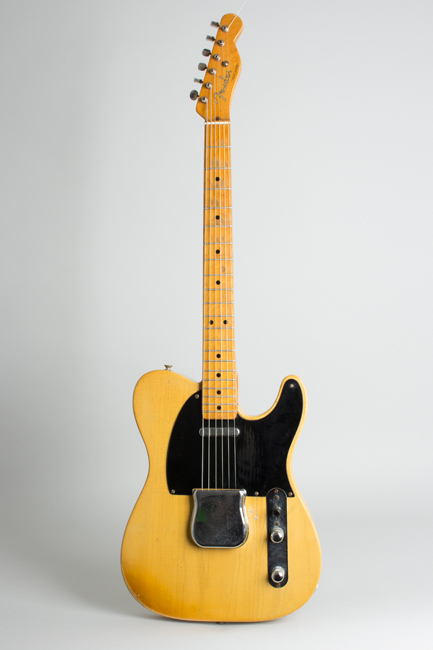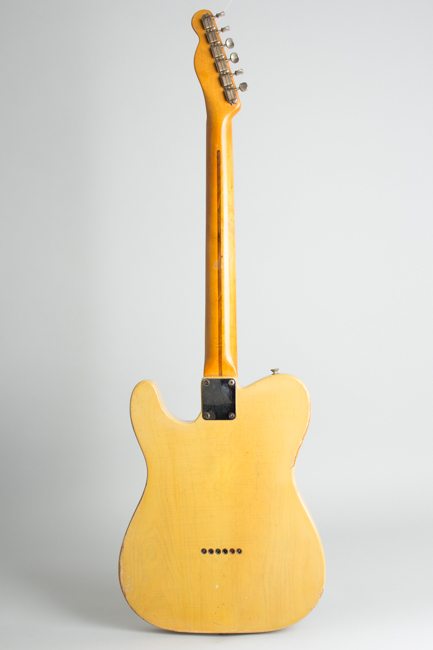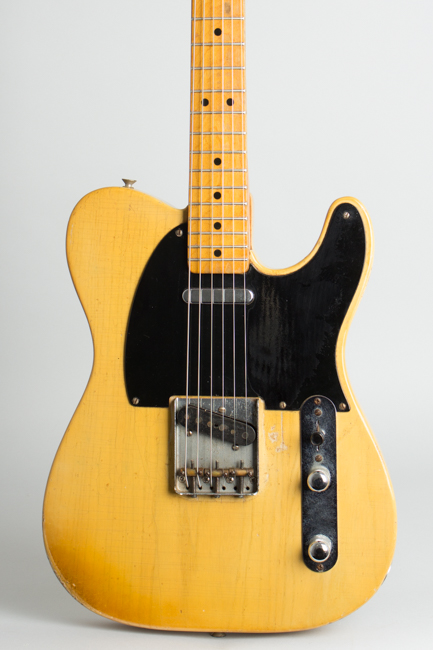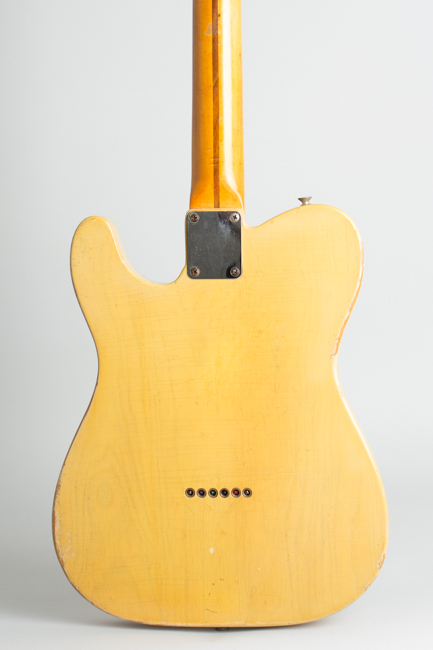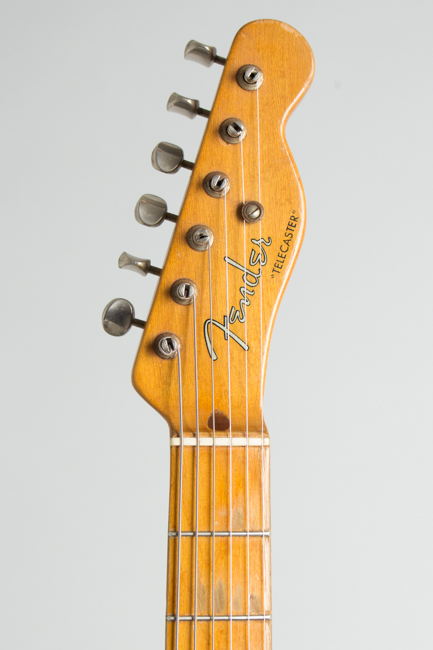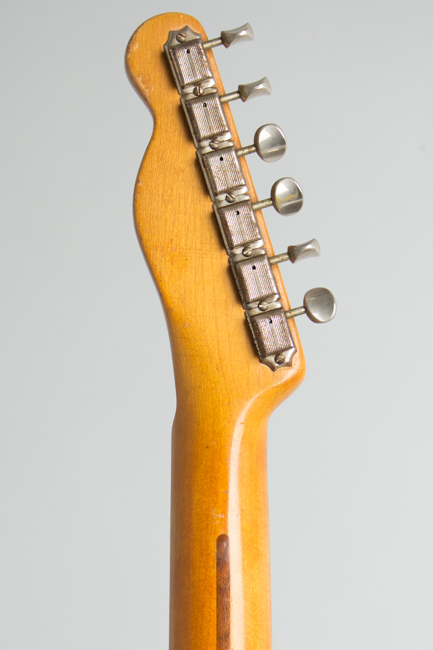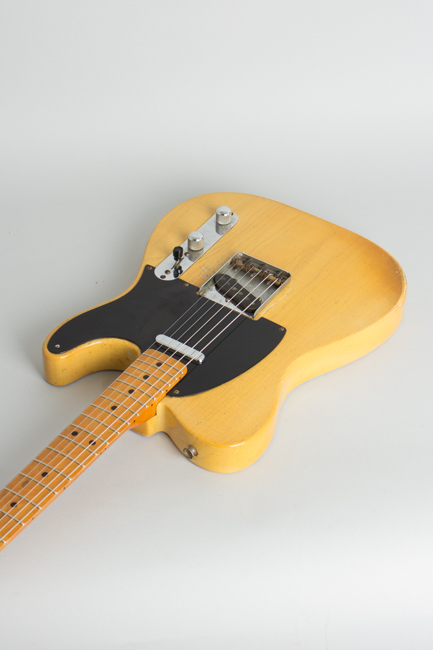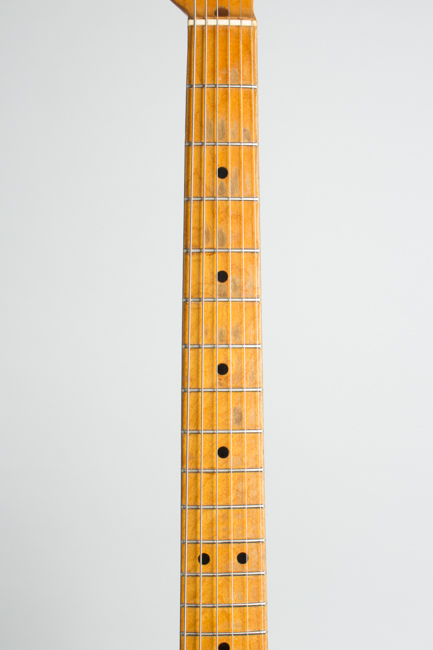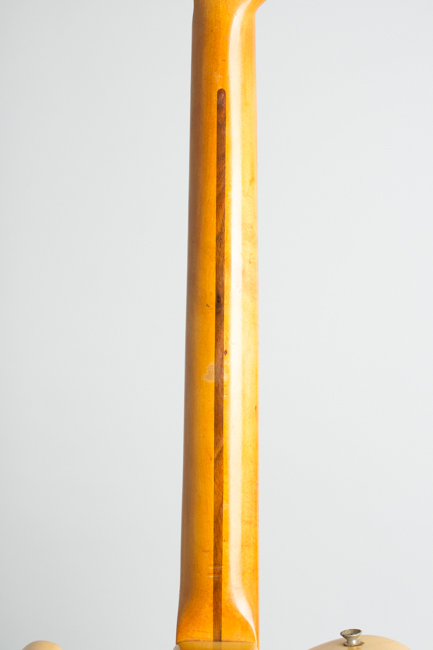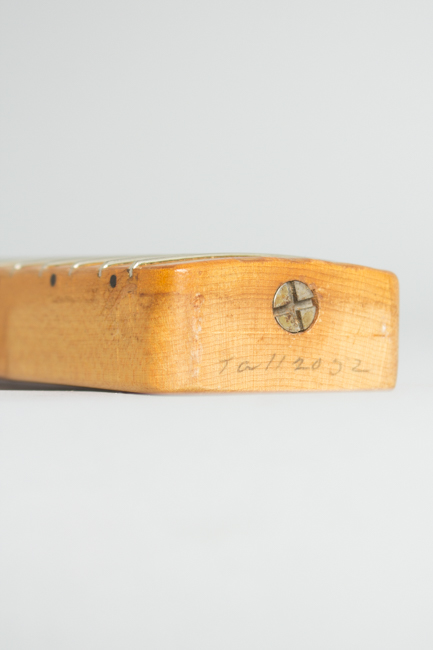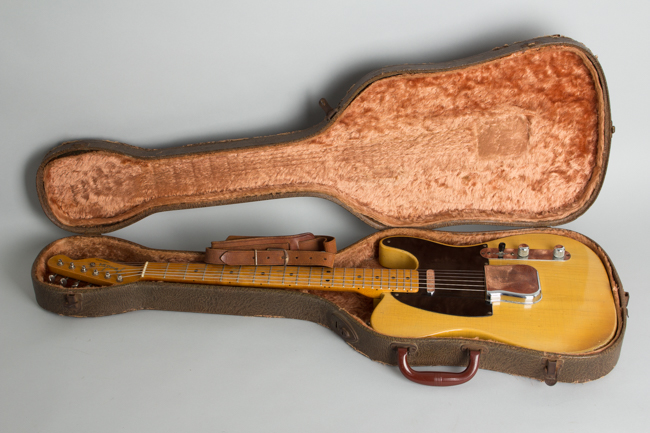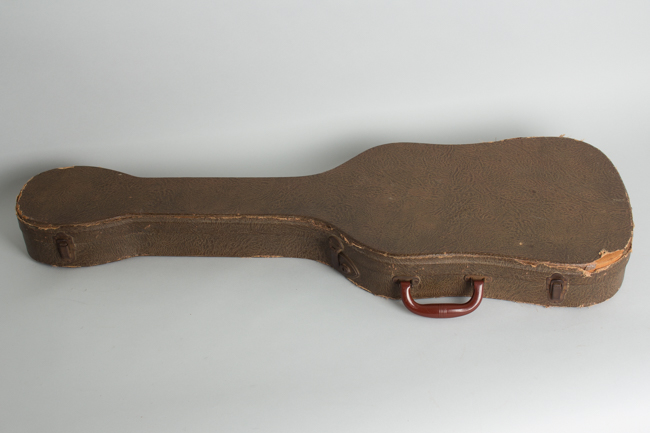Fender Telecaster Solid Body Electric Guitar (1952)
This item has been sold.
Item # 8916
Prices subject to change without notice.
Fender Telecaster Model Solid Body Electric Guitar (1952), made in Fullerton, California, Blonde lacquer finish, ash body, maple neck, original brown shaped hard shell case. This is a great sounding and playing example of a "Blackguard" Telecaster -- the guitar that put Leo Fender on the map for all time -- built at the company's original cinder-block factory in Fullerton, California towards the end of 1952. It retains all the classic '52 Tele features: the one-piece maple neck, aged "butterscotch" blonde-finished ash body, lacquered black fiber pickguard, brass bridge saddles, and of course the original black-bobbin hand wound pickups with a sound for the ages!
This guitar carries the serial number 4279 stamped into the bridgeplate, with a neck date of 11-20-52 in pencil on the heel alongside the initials of Fender's Tadeo Gomez, who signed most of the Telecasters of this period. The body carries a date mark of 11-4-52 in the neck cavity, with the penciled "Tadeo" beside. These parts are more closely dated than many early Fenders. The pot date codes are covered by solder and not possible to see.
This guitar has been played but not abused since it was shipped out in late 1952 or early 1953. All parts remain original including the early wiring rig; unlike many, it has never been re-wired to the "modern" Telecaster switching scheme. As originally set up there is a "deep bass" capacitor on the neck pickup in switch position # 1; position #2 is the neck pickup in normal mode, and #3 is the bridge pickup with a master tone control. The neck and bridge pickups can be combined by carefully lodging the selector between positions #2 and #3, which works better on this guitar than many we have had.
The very comfortable neck has a nice, round profile slimmer than some '52s we have had. The screws are mixed flat and Phillips-head types as is customary for 1952. For many, this is THE classic Telecaster year, with the same look and feel of the earliest Fender Broadcaster and "No-Caster" guitars from 1950-51, but more consistent production standards. Many of the fine details of the instrument continued to gradually evolve as the decade went along, but '52 is the benchmark year for comparison to all later Fender guitars, and the year Fender has generally selected for basing its re-issues on.
Before the introduction of the second Fender solid-body (the Stratocaster) in 1954, the Tele and Precision Bass were the company's most innovative and sensational products, and in 1952 were already causing a revolution in playing styles and shaking up the guitar world in a big way. At the time the Telecaster was totally unique in look, feel, and sound, and became instantly popular, particularly with country players. In the years since, many players and collectors have come to consider the 1952 Telecaster the finest electric guitar ever made -- and one of the most important as well.
In his authoritative and beautiful book "The Blackguard", author Nachos Banos references this, calling '52s "a personal favorite" and stating, "The neck feel and lead pickup sounds from these ... make them some of the best Fenders ever made". The early Fender Telecasters of this period are universally considered as one of the most collectible and historic of all electric guitars, and this is a very nice original example.
Overall length is 38 3/4 in. (98.4 cm.), 12 5/8 in. (32.1 cm.) wide at lower bout, and 1 3/4 in. (4.4 cm.) in depth, measured at side of rim. Scale length is 25 1/2 in. (648 mm.). Width of nut is 1 5/8 in. (41 mm.).
Overall this is a very nice late 1952 "Blackguard" with some wear and tear but no major alterations. The body finish has typical dings, dents, and worn spots, but no large areas of loss. The face is relatively "smoked" in the upper arm wear area, and has a spot of wear through the finish where a player's pinky rested just below the bridge. The edges have some finish rubbed away, as it typical with these. The neck shows wear down to the wood between the first and ninth frets, again common on 1950's Telecasters.
The guitar has been neatly refretted with the correct size wire, and there is some attendant light overspray to the neck. All hardware is original, down to the last screw. The pickguard has wear through the lacquer in the typical area below the strings. The only alteration to the instrument is at some point there was an extra screw added on the top edge of the pickguard; this has been very neatly patched but is still visible on close inspection.
Everything else is as it left Fullerton in late 1952 or early '53, with the less wear from years of hard gigging behind it than many of these. Wherever it has been this is a truly fantastic-sounding guitar, with a particularly lively and powerful bridge pickup. It is complete in the original shaped hard case -- a major rarity in itself -- with a period leather strap, original Fender Spanish guitar string envelope and a vintage good-luck rabbit's foot keychain with several keys attached. Overall Excellent - Condition.
This guitar carries the serial number 4279 stamped into the bridgeplate, with a neck date of 11-20-52 in pencil on the heel alongside the initials of Fender's Tadeo Gomez, who signed most of the Telecasters of this period. The body carries a date mark of 11-4-52 in the neck cavity, with the penciled "Tadeo" beside. These parts are more closely dated than many early Fenders. The pot date codes are covered by solder and not possible to see.
This guitar has been played but not abused since it was shipped out in late 1952 or early 1953. All parts remain original including the early wiring rig; unlike many, it has never been re-wired to the "modern" Telecaster switching scheme. As originally set up there is a "deep bass" capacitor on the neck pickup in switch position # 1; position #2 is the neck pickup in normal mode, and #3 is the bridge pickup with a master tone control. The neck and bridge pickups can be combined by carefully lodging the selector between positions #2 and #3, which works better on this guitar than many we have had.
The very comfortable neck has a nice, round profile slimmer than some '52s we have had. The screws are mixed flat and Phillips-head types as is customary for 1952. For many, this is THE classic Telecaster year, with the same look and feel of the earliest Fender Broadcaster and "No-Caster" guitars from 1950-51, but more consistent production standards. Many of the fine details of the instrument continued to gradually evolve as the decade went along, but '52 is the benchmark year for comparison to all later Fender guitars, and the year Fender has generally selected for basing its re-issues on.
Before the introduction of the second Fender solid-body (the Stratocaster) in 1954, the Tele and Precision Bass were the company's most innovative and sensational products, and in 1952 were already causing a revolution in playing styles and shaking up the guitar world in a big way. At the time the Telecaster was totally unique in look, feel, and sound, and became instantly popular, particularly with country players. In the years since, many players and collectors have come to consider the 1952 Telecaster the finest electric guitar ever made -- and one of the most important as well.
In his authoritative and beautiful book "The Blackguard", author Nachos Banos references this, calling '52s "a personal favorite" and stating, "The neck feel and lead pickup sounds from these ... make them some of the best Fenders ever made". The early Fender Telecasters of this period are universally considered as one of the most collectible and historic of all electric guitars, and this is a very nice original example.
Overall length is 38 3/4 in. (98.4 cm.), 12 5/8 in. (32.1 cm.) wide at lower bout, and 1 3/4 in. (4.4 cm.) in depth, measured at side of rim. Scale length is 25 1/2 in. (648 mm.). Width of nut is 1 5/8 in. (41 mm.).
Overall this is a very nice late 1952 "Blackguard" with some wear and tear but no major alterations. The body finish has typical dings, dents, and worn spots, but no large areas of loss. The face is relatively "smoked" in the upper arm wear area, and has a spot of wear through the finish where a player's pinky rested just below the bridge. The edges have some finish rubbed away, as it typical with these. The neck shows wear down to the wood between the first and ninth frets, again common on 1950's Telecasters.
The guitar has been neatly refretted with the correct size wire, and there is some attendant light overspray to the neck. All hardware is original, down to the last screw. The pickguard has wear through the lacquer in the typical area below the strings. The only alteration to the instrument is at some point there was an extra screw added on the top edge of the pickguard; this has been very neatly patched but is still visible on close inspection.
Everything else is as it left Fullerton in late 1952 or early '53, with the less wear from years of hard gigging behind it than many of these. Wherever it has been this is a truly fantastic-sounding guitar, with a particularly lively and powerful bridge pickup. It is complete in the original shaped hard case -- a major rarity in itself -- with a period leather strap, original Fender Spanish guitar string envelope and a vintage good-luck rabbit's foot keychain with several keys attached. Overall Excellent - Condition.
